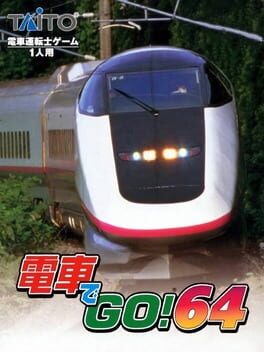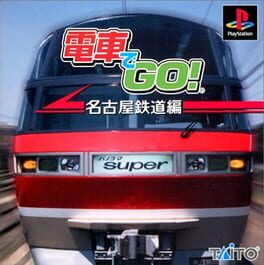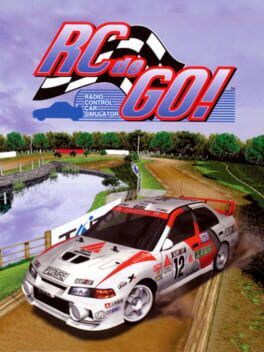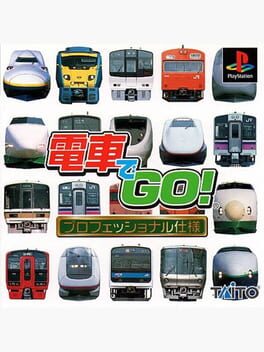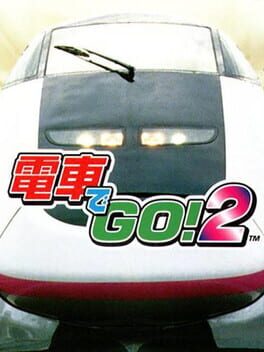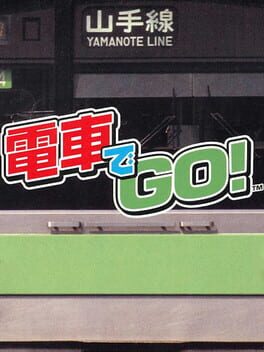

A port of Densha de Go! 2
Nintendo 64 version of Densha de Go! 2 Kousoku-hen was released as Densha de Go! 64. This expanded on the Toukaidou Main Line section, and added both a new Beginner mode and Voice Recognition Unit compatibility.
Also in series
Reviews View More
An absolute treat of a game to learn. Getting used to juggling everything you have to juggle is super great, but sadly the limited number of lines and lackluster presentation make this a little boring once you've played a couple hours. Definitely gonna dive into some of the other games in this series though, as this seems like one of the more mediocre ones (that is still admittedly probably worth playing first since it's seemingly the only one that has both a tutorial mode and an English patch).
Whilst being a very competent and genuine way to play Densha de GO! 2: Kōsoku-hen, I would only really recommend this one for newcomers in this series, for two particular reasons:
1) For us, western players, a big one: this is (as of March 2023, when I’m writing this) one of only two games in the Densha de GO! series that’s been translated into English by fans (the other one being the PC version of Densha de GO! FINAL). Playing this in English as my first game in the franchise made me able to understand how these games work, with every intricacy around controlling the train’s speed and understanding signals and penalties, and I highly recommend this version of the game to any western beginner.
2) There is a “Beginner Mode” exclusively included in this Nintendo 64 version of the game, that has a nice little tutorial course and a set of routes for you to take with basically unlimited allotted time, granting a very relaxed experience and making it super useful for newcomers to get a hang of driving different types of trains and the different schedules in each route.
Besides that, this is purely Densha de GO! 2 and, in that, besides being an extremely fine way to play that game, this provides, in my humble opinion, the most uninteresting DDG2 experience of the bunch.
When compared to other versions of the game (namely the PS1 and the Dreamcast ports, which are the ones that I’ve got the chance to play), Densha de GO! 64 has the worst graphics and sound.
Even though the 3D models look super smooth (a quirk of Nintendo 64 games in general), the textures are all blurry, and the game’s sounds, like the train engines and the announcer’s voice, are a bit muffled, with some being completely removed here (like the cute conductor lady’s voice).
Not only that, but it completely lacks the “Material Hall of Train” and the Osaka Loop Line and Kagoshima Main Line (exclusive to the PS1 version), as well as the better graphics found in the Dreamcast port.
So, even with it being based on the updated Densha de GO! 2: Kōsoku-hen 3000-bandai arcade game (just as the Dreamcast version), playing the game on the PS1, with better sound and crispier textures, as well as the inclusion of the “Material Hall of Train” and different speedometers for the Shinkansen bullet trains, makes that my personal favourite way to play Densha de GO! 2.
However, if you absolutely would HAVE to pick a SINGLE Densha de GO! game to play amongst all of them, this is maybe the safest choice.
DDG2, even with the strictness around its arcade gameplay, is a far superior game when compared to its antecessor, and it’s a joy to play. It may be the perfect representation of the “classic” DDG experience, without being so restricted as the first game was. To have this, fully in English thanks to the efforts of fans, makes it easy to go after this one if you ever found yourself curious about the franchise.
Keep in mind, though, that after you learn the game through the English translated version, it makes the language barrier in every other game in the series basically nonexistent. For real.
So, as much as you like what you can get here, remember there are a couple of better ways to play it. :)
1) For us, western players, a big one: this is (as of March 2023, when I’m writing this) one of only two games in the Densha de GO! series that’s been translated into English by fans (the other one being the PC version of Densha de GO! FINAL). Playing this in English as my first game in the franchise made me able to understand how these games work, with every intricacy around controlling the train’s speed and understanding signals and penalties, and I highly recommend this version of the game to any western beginner.
2) There is a “Beginner Mode” exclusively included in this Nintendo 64 version of the game, that has a nice little tutorial course and a set of routes for you to take with basically unlimited allotted time, granting a very relaxed experience and making it super useful for newcomers to get a hang of driving different types of trains and the different schedules in each route.
Besides that, this is purely Densha de GO! 2 and, in that, besides being an extremely fine way to play that game, this provides, in my humble opinion, the most uninteresting DDG2 experience of the bunch.
When compared to other versions of the game (namely the PS1 and the Dreamcast ports, which are the ones that I’ve got the chance to play), Densha de GO! 64 has the worst graphics and sound.
Even though the 3D models look super smooth (a quirk of Nintendo 64 games in general), the textures are all blurry, and the game’s sounds, like the train engines and the announcer’s voice, are a bit muffled, with some being completely removed here (like the cute conductor lady’s voice).
Not only that, but it completely lacks the “Material Hall of Train” and the Osaka Loop Line and Kagoshima Main Line (exclusive to the PS1 version), as well as the better graphics found in the Dreamcast port.
So, even with it being based on the updated Densha de GO! 2: Kōsoku-hen 3000-bandai arcade game (just as the Dreamcast version), playing the game on the PS1, with better sound and crispier textures, as well as the inclusion of the “Material Hall of Train” and different speedometers for the Shinkansen bullet trains, makes that my personal favourite way to play Densha de GO! 2.
However, if you absolutely would HAVE to pick a SINGLE Densha de GO! game to play amongst all of them, this is maybe the safest choice.
DDG2, even with the strictness around its arcade gameplay, is a far superior game when compared to its antecessor, and it’s a joy to play. It may be the perfect representation of the “classic” DDG experience, without being so restricted as the first game was. To have this, fully in English thanks to the efforts of fans, makes it easy to go after this one if you ever found yourself curious about the franchise.
Keep in mind, though, that after you learn the game through the English translated version, it makes the language barrier in every other game in the series basically nonexistent. For real.
So, as much as you like what you can get here, remember there are a couple of better ways to play it. :)
